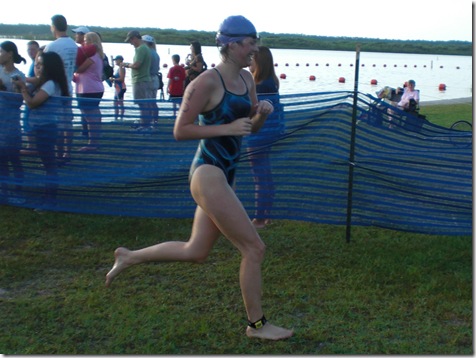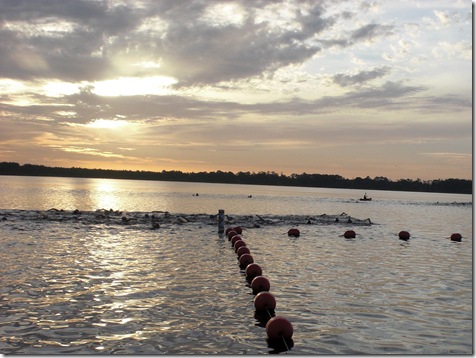This information was originally published as a two-part series (How to Swim Part I and Part II).
Hi Healthy Tipping Point readers! My name is Ryan and my blog is called Greens for Good.
After helping Caitlin with her swimming technique, she asked me to write a post with some swimming tips. I started swimming competitively when I was 7 years old, continued through high school, contemplated swimming in college but decided not to because of a shoulder injury, and switched gears by becoming a swim instructor instead. So whether you’re training for your next triathlon like Caitlin, or would like to improve your recreational swimming techniques, I hope I can help. If you have any questions following this post, please visit my contact page or email me: ryan [at] greensforgood [dot] com.
There are a few important things you want to remember while swimming the most commonly known stroke: freestyle (on your stomach with arms rotating forward while kicking your feet). If you’re swimming in a triathlon or even just for exercise, this will likely be the stroke you use. Seasoned swimmers might cross-train for race events with the other three strokes (backstroke, breaststroke, and butterfly), but for our purposes, we’ll focus on freestyle.
The next time you jump in the pool, focus on one of these 4 areas at a time so that you don’t become overwhelmed. When you feel comfortable, put it all together and you should feel like you’re doing much less work to move across the pool. Proper technique = fast, energy-saving, efficient swimming.
1. How to hold your entire body:
- Starting with your head, keep it straight out if front of you with a straight neck. Don’t tuck your chin. The water line should remain at the top of your forehead (hairline) so that you can look forward slightly if needed.
- Your shoulders should ride at the surface of the water as they rotate in and out of it.
- Your hips and feet should ride slightly below the surface of the water. This might seem hard to do, but it’s important to keep it in mind because as your hips sink, your feet sink and you create a wall with the bottom of your body that your upper body has to work harder to pull through the water. If you need help with this, get a swim buoy like this one, place it between your legs, near the crotch, and you’ll quickly feel how your lower body should be positioned. If you’re using a buoy, do not try to kick (you’ll chafe). Instead, focus on your upper body techniques and enjoy not having to worry about your lower body!
- Swim straight. Pretend there is a pole running through the center of your body that prevents you from wiggling from side to side when you’re swimming. Sometimes our rears wiggle as we go down the pool to compensate for other parts of the stroke that are being done incorrectly. If you can’t tell if you’re wiggling, ask someone to watch you.
- While you shouldn’t move from side to side, your body should be rotating from left to right as you swim. Your entire body should rotate about 45 degrees up on the left side when you’re extending your right arm in front of you and 45 degrees up on the right side when your left arm is in front of you.
2. How to move your arms:
- Your arms should reach out in front of you, one at a time, and rotate from the start of your stroke to the end of it. If your right arm is in front of you, your left should be half-way through the stroke rotation, in the water, by your hip.
- Out of the water: When your arms are out of the water, your elbows should be slightly bent and your fingers should be almost perpendicular to the bottom of the pool as your arms sweep around to the front of your head.Do not straighten your arms by reaching them as high up as you can or by swinging them out of the water, straight to the side, and around to the front of your head. This is inefficient and your stroke will take a lot more time to complete.
- Out of the water: Your hands should enter the water in front of your head when your elbow is still bent. A common mistake that beginning swimmers make is straightening their arms before their hands enter the water. Instead, enter the water with a bent elbow and rotate your body to get the full extension of your arm before pulling it back.
- Under the water: When your arms are under the water and your hand is moving back toward your hips, keep your elbows bent and straighten just as your hand is about to exit the water. Just like when they are out of the water, you don’t want to keep them straight and reaching toward the bottom, or pulling out wide either.
- Under the water: When your hand enters the water, rotate your body to get a few more inches of reach, then pull your hand back and pretend your are pushing the water out from underneath your sides. Before your hands leaves the water, give them one last good push and make a slight splash when they finally exit the water by your hips.
- Overall, keep your stroke tight and close to your body. You want to complete the rotation of your arms are quickly and efficiently as possible.
3. How to move your legs:
- Think of kicking from your hips, rather than your knees. Kicking primarily from your knees will cause your lower body to sink. Your knees can bend slightly in the upward motion of your kick.
- Your legs should alternate, one up, one down, while kicking. Your feet should be pointed (I call them ballerina feet when teaching young kids).
- Your kick should resemble a butterfly’s fluttering wings. After all, we do call it a flutter kick for a reason! Quick, short movements just under the surface of the water will keep your upper body from overworking to compensate for an improper kick.
- You shouldn’t be splashing too much unless you’re sprinting. By keeping your feet moving quick under the surface of the water, you’ll cause the surface to break and splash just a little. The more splashing you’re doing, the more time your feet are spending out of the water, defeating the purpose of your kick and ultimately wasting your energy.
4. How to breathe:
- Breathing efficiently is key to not interrupting the rhythm of your stroke. To do this, always exhale under water and inhale out of water.
- Turn your head to the side when one arm is in front of you (by your head) and one arm is behind you (by your hip). So if your right arm is in front, turn your head to the left. If your left arm is in front, turn your head to the right. Inhale. Turn your head back into the water and immediately begin to slowly exhale. Exhale completely under water before turning your head again for another breath.
- As you get more comfortable and more in shape, work on not taking too many breaths. Even the most efficiently formed breathing slows a swimmer down.
Let me know how it goes for you. Happy Swimming!



